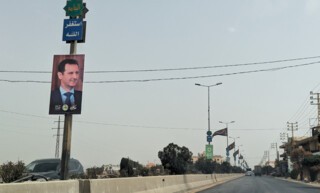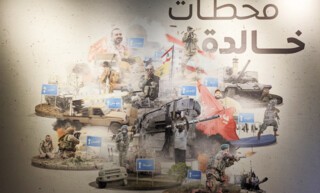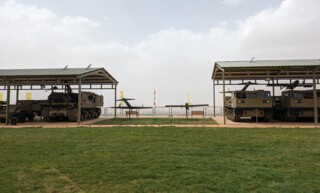In Baalbek
Stefan Tarnowski
In Lebanon’s official discourse, Syria is often described as suriya al-shaqiqa, ‘full-sister Syria’. The phrase refers to the two countries’ shared pre-colonial origins, before the ‘unnatural’ borders established by Sykes-Picot separated them, and belies their fraught post-colonial relationship. In her book on the history of Lebanese-Syrian relations, Elisabeth Picard refers to the two countries as intimes étrangers. It’s hard to say whether the terms are contradictory, or whether ‘intimate stranger’ is an apt description of the sibling relation.
If you turn off the highway from Beirut to Damascus before reaching the border and head north towards Baalbek, a well-trodden path on Lebanon’s tourist trail, the billboards with brand names peter out. For as long as I can remember, the central reservation has been hung with Hizbullah flags and pictures of party leaders, martyrs and militia commanders. Two weeks ago, when I went to visit the newly opened Hizbullah museum on the outskirts of Baalbek, many of those flags and posters had been taken down and replaced with Syrian Baath Party flags and portraits of Hafez and Bashar al-Assad.
The Hizbullah museum is the latest addition to a portfolio of sites that produce an ‘Islamic milieu’, as Lara Deeb and Mona Harb put it in Leisurely Islam: Negotiating Geography and Morality in Shi’ite South Beirut. The most famous and best funded is the Resistance Museum in Mleeta, which opened in 2010. Visitors trek up to the crest of a hill and into a complex of bunkers and tunnels, where they learn about the hardship and discipline required to be a member of the only fighting force in the Arab world that has forced Israel to withdraw unilaterally from territory it illegally occupied.
It’s the same force that fought – and controversially claimed to have won – the July 2006 war, when Israel re-invaded and bombarded Lebanon. That war marked the high point of Hizbullah’s media strategy. The most famous episode came when Hassan Nasrallah, the organisation’s leader, interrupted an IDF press conference on al-Manar, Hizbullah’s satellite channel. Speaking from his underground bunker, he told the residents of Beirut to look to the sea. The image cut to footage of an Israeli warship floating off the coast, blockading the city. ‘Look at it burn,’ he said, as the live broadcast showed a rocket crash into the ship.
The attack features in the exhibition at the new Baalbek Museum, ‘an artistic and engineering panorama that narrates some of the resistance’s sacrifices and triumphs’, from Hizbullah’s inception in 1982 during the Israeli siege of Beirut to ‘the first liberation in 2000’, the ‘great divine victory of 2006’ and ‘the second liberation in 2017’. The liberation of South Lebanon from Israeli occupation in 2000 was a moment of national jubilation. But what is the second liberation? Liberation from whom? From what?
The purpose of the display, which is in Arabic only, is to use Hizbullah’s past as a resistance organisation to justify its present politics, and to elide any shifts by claiming those politics are ‘eternal’. The central wall lists the group’s ‘Eternal Stations’. Alongside the signposts marking ‘South Lebanon’ and ‘Jerusalem’, which have always featured in Hizbullah’s ‘resistance’ discourse as places to be liberated, there are new signs for Homs, Deraa, Ghouta, Aleppo and half a dozen other Syrian towns and cities.
A continuous timeline runs along the perimeter of the exhibition space. For the first two decades there’s a counter tallying the number of ‘operations’. It stops in 2000, though Hizbullah didn’t cease military operations after the Israeli withdrawal. Instead, the militia’s weapons were increasingly used in domestic politics, culminating on 8 May 2008, when it seized control of West Beirut in a dispute over telecommunications infrastructure.
The timeline doesn’t omit the announcement in 2013 when Hizbullah finally admitted to sending fighters ‘to participate in the war in Syria’. That, in fact, is the point of the museum. But unlike at the museum in Mleeta, there’s no attempt to recreate the ‘resistance’ experience for visitors. In Baalbek, at the crest of a hill there’s a lawn and a neat parking lot of military vehicles: tanks, armoured personnel carriers, trucks. The lawn was being mowed when I visited.
Since 2014, I’ve done fieldwork with Syrians who live in the Beqaa Valley, forcibly displaced by Assad’s forces and their allies. When they describe their experiences at the hands of Hizbullah, it’s as brutal as anything committed by an invading army waging a war of aggression: siege, bombardment, massacre, rape. The continuity of the term ‘resistance’ in the museum display is the record of an old word dying. The timeline omits the mass protests that began in Syria in 2011, and it stops abruptly in 2017, before the October 2019 protests in Lebanon, which Hizbullah also played a role in quelling. Protesters call both these movements a revolution. Its absence reveals an old word struggling to be reborn for more than a decade.
In August, protests restarted in Sweida, southern Syria, led by the Druze community. The demonstrators began by demanding an end to conscription in Assad’s army, but have since moved on to protesting at the dire economic conditions in the country, calling for the implementation of Security Council Resolution 2254 and even ‘the fall of the regime’. For weeks, the local Baath Party headquarters in Sweida were forced to shut.
As the posters of Assad and the Baath Party are pulled down in Syria, they pop up along the road to Baalbek. In the meantime, the Lebanese parliament is preparing a law to deport Syrian refugees: for the Syrian state, it’s acting like a good sibling. But for the Syrians still forcibly displaced after more than a decade, unable to return to their homes while Assad remains in office propped up by foreign allies, the Lebanese state remains an intimate stranger.


